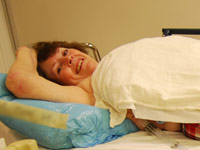Posted March 14, 2011
UC Davis Cancer Center now offers a new generation of radiation therapy that transforms a woman’s breast cancer radiation treatment experience.
The method is the newest and most sophisticated form of “accelerated partial-breast irradiation,” in which a conformal catheter is implanted temporarily into the cavity where the tumor has been surgically removed. The treatment, which takes just five days, is applied directly to the tumor site and minimizes radiation exposure to the heart, lung, ribs and skin. Accelerated partial-breast irradiation also focuses radiation on the area where 90 percent of breast tumors recur, close to the tumor bed.
“This program has several advantages over earlier programs that used older-generation radiation catheters,” said Jyoti Mayadev, assistant professor of radiation oncology at UC Davis Cancer Center. “The main advantage is that we can sculpt the radiation dose away from critical, normal structures and target the area at higher risk of recurrence, which is where the tumor started.”
UC Davis Cancer Center is the only cancer treatment facility in the Sacramento metropolitan area that offers the new treatment method. Use of the technique represents a multi-disciplinary team approach involving cancer specialists in both surgery and radiation therapy.
Steven Chen, a UC Davis surgical oncologist, said the procedure is generally appropriate for women over 50 with early-stage breast tumors that have not spread to lymph nodes. Chen estimated that more than half of women diagnosed with breast cancer would be eligible for this type of radiation therapy.
“The main advantage is that we can sculpt the radiation dose away from critical, normal structures and target the area at higher risk of recurrence, which is where the tumor started.”
—Jyoti Mayadev, assistant professor of radiation oncology at UC Davis Cancer Center.
The radiation therapy delivery occurs within weeks of a patient’s lumpectomy, a surgery in which the tumor is removed but the breast is conserved.
First, physicians use a CT scan to map the lumpectomy cavity and determine where to place the treatment applicator, said Mayadev. Once mapping is complete, a surgeon makes a small incision in the breast and places the thin applicator into the tumor bed. Within a day or two, the patient returns to the radiation oncology clinic for treatment planning.
The device itself contains a bundle of very thin catheters that attach on one end and can be expanded to conform to the shape of the cavity. The radiation is delivered through each catheter using a remote after-loading system, which is then disconnected until the next treatment. Unlike normal breast radiation therapy, which exposes the entire breast to radiation five times a week for up to six weeks, the new approach takes just two visits per day for five days.
Dolly Keehne of Penn Valley said she is not normally a good patient and almost couldn’t get through her breast biopsy. So she dreaded radiation therapy after her tumor removal surgery. “I’m scared, and I shake,” she said. “But this was so much easier than I anticipated. It was pain-free. From the first day to the last, it was unbelievable.”
After her breast cancer diagnosis in July 2010, Keehne had searched for a program that offered the partial-breast irradiation approach. She had already endured kidney cancer treatment and wanted limited radiation exposure this time around.
“In the past five years, I have had at least 40 CT scans,” she said. “I was afraid of having six weeks of radiation treatment. I jumped on the bandwagon because they could direct the radiation dose.”
The treatment was painless and did not cause fatigue. “Treatment ended on Sept. 17, and I went to my nephew’s wedding in Pismo Beach the next night. I felt fine.”

Margaret McCoy of Rio Linda completed her treatment in mid-October. She said the entire experience was far easier than she had expected. “It was kind of scary to think about when they said they were going to put a device in my breast,” she said. “But it was a piece of cake.”
After her final treatment, McCoy said she and her daughter celebrated at a restaurant with dinner and a margarita.
Mayadev said the new approach improves on the older generation of partial-breast techniques because it requires just one incision instead of the insertion of many needles, while still keeping the flexibility of having many catheters to use to distribute the dose. The procedure is more comfortable for the patient without compromising on the distribution of the radiation dose.
Research has found that results with partial-breast irradiation are similar to results with whole-breast radiation therapy, which decreases the chance of tumor recurrence by more than 60 percent.
Mayadev said the new approach enhances the cancer center’s wide-ranging armamentarium against breast cancer. “We can increase the local control while significantly lowering radiation doses to critical areas,” she said, “potentially decreasing the risk of long-term radiation effects such as cardiac morbidity and radiation lung scarring.”
UC Davis Cancer Center is the only National Cancer Institute- designated center serving the Central Valley and inland Northern California, a region of more than 6 million people. Its top specialists provide compassionate, comprehensive care for more than 9,000 adults and children every year, and offer patients access to more than 150 clinical trials at any given time. Its innovative research program includes more than 280 scientists at UC Davis and Lawrence Livermore National Laboratory. The unique partnership, the first between a major cancer center and national laboratory, has resulted in the discovery of new tools to diagnose and treat cancer. Through the Cancer Care Network, UC Davis is collaborating with a number of hospitals and clinical centers throughout the Central Valley and Northern California regions to offer the latest cancer-care services. For more information, visit www.ucdmc.ucdavis.edu/cancer.